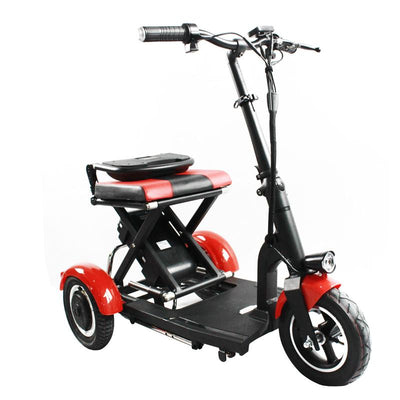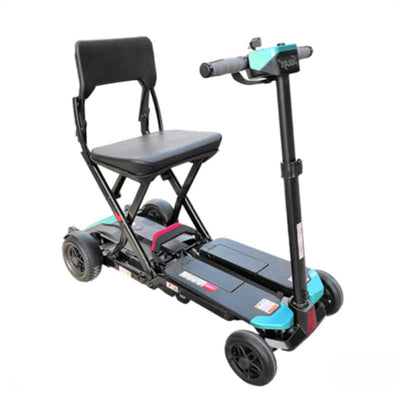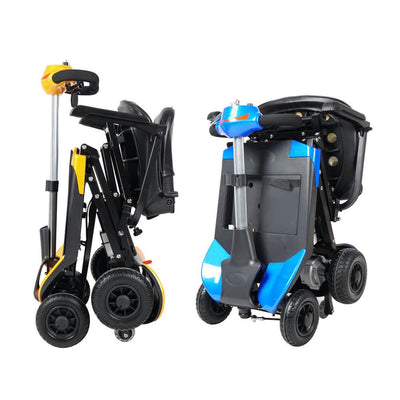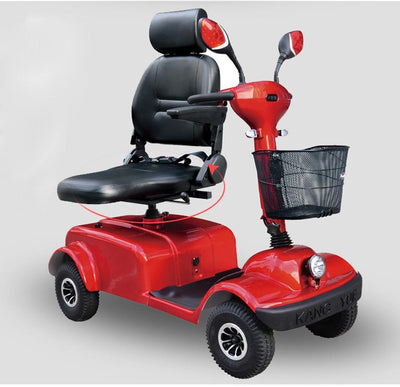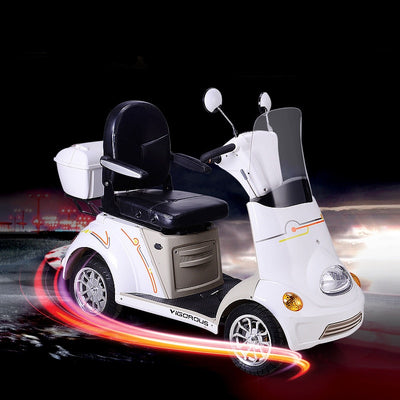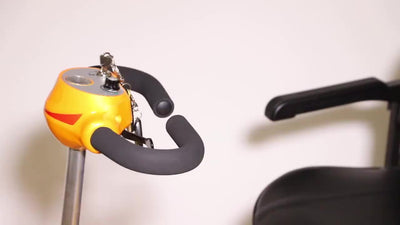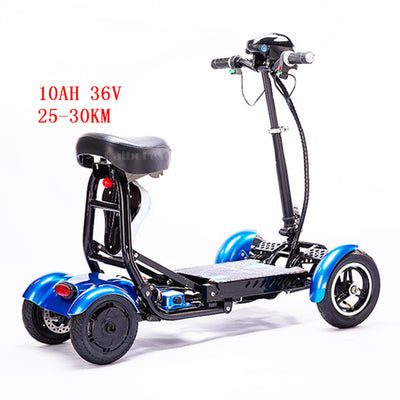Ultimate FAQ Guide To Mobility & Electric Equipment
Charging

Can I charge the battery with a car charger?
No. Batteries should never be charged with a car charger - doing so risks damaging the device.
How long does it take to fully charge the batteries?
Battery charging takes an average of 6 to 8 hours. Achieving a full charge can take up to 12 hours. Most mobility units or electric models include chargers with automatic shut off, allowing the user to plug in the charger at night and have fully charged batteries by the morning without the risk of overcharging.

How often should I charge my battery?
We recommend you charge it every night. It’s also a good idea never to leave the house without a fully charged battery. Bringing your battery charger wherever you go is likewise an important safety measure - just in case you find yourself in a situation where you need to recharge.
Extra Charges
Do mobility vehicles need road tax and insurance?
They do not currently require road tax or insurance.
Use and Performance
How to make my vehicle go faster?
You can try adjusting the settings – refer to the manual guide - or it might just be a matter of learning how to use the controls.
Are they allowed in stores?
Unfortunately, they are often not allowed in stores.
Can you rent one?
Yes, certain companies allow you to rent models. These can often be found online or in high tourist locations.
How to drive one?
Ensure you are seated comfortably and have the controls firmly held. Exactly how one may be driven will depend on the controls it uses. It might have a wheel, handles, or a joystick for input. Always refer to the model’s user guide.
How do you lock them?
You can lock your device with the provided start key. Many models have other anti-theft measures installed as well.
Should I buy One?

When to get a mobility vehicle?
You should consider getting mobility equipment when you can support yourself in navigating small distances but require assistance in moving larger distances. After discussing your situation with a doctor, a vehicle is often the best option.
Do you have to be disabled to use one?
No, you can use one regardless of whether or not you have any disabilities.
What are they used for?
Mobility equipment assists those requiring help in moving in their day-to-day life. They aim to provide independence and mobility – all in comfort and ease.
Taking Care of Your Device
How much is insurance?
Mobility insurance can depend on the provider. The prices typically range between $65-$200 depending on the type of service provided and the time period covered.
How and where should I store it?
A mobility vehicle should ideally be stored indoors – keeping it out of the elements ensures longer durability. Indoor battery charging is also simply more practical.
Capabilities
Speed
How fast can a mobility vehicle go?
The average speed is 4 mph (6.5 kph), though heavy-duty models can reach speeds of 15 mph (24 kph). Different models go at different speeds – check your model.
Range
How far can I go on a full battery charge?
At the very least, units have a range of 5 miles (8 km), but very commonly reach over 10 miles (16 km). Some higher-end models are actually capable of 45 miles (72 km)! Each model has a different range and this is an important factor to consider when selecting yours.
Can I buy a battery that will last longer and allow me to go a longer distance?
Yes. This is often an option when buying your device and may be also arranged by contacting the manufacturer. Note, however, that many models are limited to specific batteries that are unchangeable.
Weight
What is the maximum weight they can carry?
There are specific weight limits depending on the model. The supported weight range is between 250 lbs through 450 lbs, with many options in between.
Troubleshooting & Repairs
Why is my device going slowly?
You can try adjusting the settings or it might just be a matter of learning how to use the controls. If you’ve had your device for a while, it might be an indication that your batteries need replacing.
Remember: there is a weight capacity limit. If the combined weight (including shopping etc.) exceeds this limit, you won’t be getting optimal performance.
If you’ve recently been over a fair number of curbs and potholes or exposed your device to water/ dust, these might have damaged the motor, resulting in slower speeds.
Who repairs them?
If there are any issues, manufacturers will repair mobility vehicles according to their warranty plan. Additional convenient options are available such as in-home service contracts from your retailer.
Scooters 'N Chairs has partnered with WSR Solutions to provide you with repair services in the event that your warranty has expired and is not covered by the supplier.
Vehicles in Different Environments
Terrain
Can I take my equipment in the grass and on uneven surfaces?
Most are intended for paved pathways and will not perform well on dirt, gravel, or grass surfaces. There is a range of heavy-duty models out there that will perform significantly better on these more rugged surfaces.
The Elements
Can you use them in the rain?
Yes. Choose a model that features a built-in canopy for full protection.
What is the best electric model for outdoors?
The Pride Mobility Jazzy Elite HD is an outstanding luxury unit. Its large wheels provide maximum traction on challenging terrain, and it can turn all those tight corners. With a huge range of styles and sizes to choose from, you get ultimate flexibility and comfort.
For those on a lower budget, our recommended choice is Golden Technologies Alante Sport. The Golden Technologies brand represents high quality and they’re ready to back that up with a free 5-year warranty on the frame.
Portability & Travel

Weight
How much do they weigh?
Mobility vehicles weigh anything between 44 pounds (20 kg) to 400 pounds (180 kg). Choose a model that suits your needs.
What is the weight of a lightweight electric unit?
You can expect a lightweight model to weigh around 130 pounds (60 kg).
Which is the lightest mobility vehicle?
Easy Rider’s Transport Easy Move S19m is a highly recommended, super light product. At 44 pounds (20 kg) it really makes traveling with your device a pleasure.
How heavy is a motorized wheelchair?
A basic motorized wheelchair can weigh as little as 60 pounds (27 kg). For more luxurious power chairs, the figure is more like 200-300 pounds (90-140 kg).
How heavy is a standard power chair?
On average, 200-300 pounds (90-140 kg).
Easy Transport
How should I transport my device?
Certain models can be folded or disassembled for easy transportation. These models are often relatively especially lightweight. Look out for them if this is something important to you.
Which product is best for travel?
Any foldable model is suitable for travel. The best model for you will depend on your particular needs – compactness is important to some and weight is the big deal for others.
Public Transportation
Can they go on buses?
In many instances, yes. The Confederation of Passenger Transport (CPT) has launched a Code of Practice aimed at regularising the carriage of mobility vehicles on buses. The Code sets out which models are allowed on buses and which are not, based on size.
Can you take them on a plane?
Yes. People commonly believe you can’t, but as long the batteries are gel-cell, it’s absolutely okay to do so. It’s best to notify the airline so they can make the appropriate arrangements in advance. Some airlines even allow lithium-ion batteries – check before you fly.
Are they allowed on trains?
Some trains and train companies permit them, others require permits. It’s best to check before traveling.
Mobility Equipment & The Law
General
Do I need a driver’s license to operate one?
No. They are considered pedestrian transportation.
Can you drive one drunk?
No, you should never operate a vehicle while intoxicated. Drunk-driving is dangerous both to yourself and those around you.
Sidewalks & Roads
Can I drive my device on the road?
Most mobility products are not legally allowed on the road – they’re designed to function as a pedestrian means of transportation.
Are electric models legal on sidewalks?
Yes, they are considered pedestrian transportation so they can definitely be used on sidewalks.
Are electric wheelchairs street legal?
Electric models are intended to provide pedestrian mobility. In the US, your device should not be used on main roads. Keep it on pedestrian pathways (sidewalks, crosswalks, and walking paths). Where no sidewalk or path is available, you may use the roadway as any pedestrian would.
Are they allowed in shops?
Unfortunately, mobility devices are often not allowed in stores.
Will Insurance Cover My Device?
Insurance
Are they covered by insurance?
Technically speaking, yes. But bear in mind the paperwork involved is tedious, needing to pass many levels, and will take a few months to complete.
Are they covered by insurance (where purchased online)?
Unfortunately, those sold online are not covered by insurance. However online retailers are an extremely convenient way to access a huge range of the best and most reasonably priced electric wheelchairs and mobility scooters on the market.
Medicare
Are electric models covered by Medicare?
Yes. But bear in mind the paperwork involved is tedious, needing to pass many levels, and will take a few months to complete.
Are they covered by Medicare (when purchased online)?
Those purchased online are not covered by Medicare. There are strict rules regulating the way Medicare can be used - Medicare will only cover products obtained through Medicare doctors and providers.
Will medicare pay for my mobility equipment?
Medicare will cover your mobility needs as determined by your health provider. Any equipment provided by Medicare is determined on a case by case basis. As an example, Medicare will cover 80% of the costs for prescribed wheelchairs. You would then pay the remaining 20% (copay).
Can a doctor prescribe a wheelchair?
Yes, a doctor can prescribe a wheelchair.
What equipment is covered by Medicare?
Walkers and wheelchairs are all considered durable medical equipment (DME), which is typically covered by Medicare. Mobility devices are also covered if they are considered medically necessary and are prescribed by a doctor.
Will Medicare cover pay for a mobility vehicle purchased online?
No. Online retailers are an extremely convenient way to access a huge range of the best and most reasonably priced products on the market. Unfortunately, the strict rules governing Medicare suppliers prevent them from offering an online option.
Medicaid
Are electric vehicles covered by Medicaid?
Technically yes. But bear in mind the paperwork involved is tedious, needing to pass many levels, and will take a few months to complete. Medicaid will then pay for the majority of the mobility unit - up to 80% - and you would pay a 20% deductible (copay).
Will Medicaid pay for a wheelchair?
Yes and no. Medicaid will pay for the majority of the mobility unit - up to 80% - you would only need to pay as little as a 20% deductible (copay).
Veteran Affairs
Does the VA provide mobility equipment?
Yes. In certain circumstances the VA does provide mobility assistance.
Buying, Pricing & Costs
Veteran Affairs
How much is insurance?
Mobility insurance costs depend on the provider. The prices typically range between $65-$200 depending on the type of service provided and the time period covered.
Are batteries and a charger included with the final mobility product price?
Yes, batteries and a charger are included in the prices listed on our site.
Do they need road tax and insurance?
Mobility vehicles do not currently require road tax or insurance.
How much is a rental?
Price will vary from location, use, duration, and transportation. You can find starting prices at $30 per day.
Where to Buy
Where to buy one?
They can be purchased through trusted online providers, directly from manufacturers, and via Medicaid doctors (provided the customer has Medicaid as well). For a list of the best products check out our online inventory and search the best brands.
Batteries & Charging
Batteries
How long should a battery last?
A battery should last a few years without any issue.
What type of batteries do mobility units use?
Several different types of batteries are used by vehicles. Two popular technologies are lead acid and gel-cell. Gel-cell batteries come sealed so they require almost no maintenance.
Although they cost more than other kinds, gel-cell batteries are extremely safe and will never leak. They are FAA certified batteries so you can take them on aeroplanes. Lead acid or wet-cell batteries are cheaper but they’ll need to maintain them (topping up water and acid levels).
They last a little longer than gel-cell batteries but do carry the risk of acid spills. To increase range whilst maintaining a low overall weight, some feature newer technology lithium-ion batteries. Some airlines permit these – check before you travel.
Can I buy a battery that will last longer and allow me to go a longer distance on a full charge?
Yes. This is often an option when buying your device and may be also arranged by contacting the manufacturer. Note, however, that many models are limited to specific batteries that are unchangeable.
How much are batteries?
On average, gel-cell batteries sell for $90 with lead acid types selling for significantly less.
Are batteries and a charger included with the final price?
Yes, batteries and a charger are included in the prices listed on our site.
Charging
Can you overcharge a battery?
Yes. Difficulties can occur if a battery is either undercharged or overcharged. How long does it take to fully charge a mobility vehicle? Battery charging takes an average of 6 to 8 hours. Achieving a full charge can take up to 12 hours. Most models include chargers with automatic shut off, allowing the user to plug in the charger at night and have fully charged batteries by the morning without the risk of overcharging.
How often should I charge my battery?
We recommend you charge it every night. It’s also a good idea never to leave the house without a fully charged battery. Bringing your battery charger wherever you go is likewise an important safety measure - just in case you find yourself in a situation where you need to recharge.
How far can I go on a full battery charge?
At the very least, vehicles have a range of 5 miles (8 km) on one full battery, but they very commonly reach over 10 miles (16). Some higher-end models are actually capable of 45 miles (72 km)! Each model has a different range and this is an important factor to consider when selecting your device.
Charging
What is the highest rated electric (power) model on the market?
The Jazzy Select Elite is another superb product! The Pride Mobility brand represents Premium quality and they’re ready to back that up with a free Platinum 3-year warranty.
What are the best electric wheelchairs in 2019?
We would give that title to Golden Technologies Compass Sport & Drive Medical’s Trident. Both are models of superb craftsmanship, attention to detail and flexibility. The Trident offers great power with its front wheel drive and is very reasonably priced. If you’re looking for a guaranteed, no-worries product, the Compass Sport is backed by a lifetime warranty!
Which is the best folding model?
The Drive Medical Zoo-Me series is the place to go for a selection of the very best folding units. Choose between automatic close or manual close – both only take one easy motion/touch to collapse. They’re super light - all under 60 lbs (27 kg) - for travelling with and storing your device has never been easier.
What is the best mobility vehicle for outdoors?
If you’re looking for protection from the elements, look out for models that include a cover or canopy. You might plan on using your device off-road, if so, you’ll need a model with high ground clearance to avoid all those bumps. Go for the Drive Medical Cobra GT4. It’s a meticulously designed, sophisticated outdoor unit with a massive ground clearance of 7” (18 cm).
Which is the lightest model?
Easy Rider’s Transport Easy Move is a highly recommended, super light product. At 44 pounds (20 kg) it really makes traveling with your device a pleasure.
Which one is best for travel?
Any portable model is suitable for travel. The best model for you will depend on your particular needs – compactness is important to some and weight is the big deal for others.
What is the best electric vehicle to buy?
When it comes to electric wheelchairs the Pride Jazzy Passport takes the first place. A modern look, high-tech regenerative braking and unrivalled transportability make this great value for money wheelchair an absolute catch!
Electric Wheelchairs
How much does it cost to buy a power model?
Typically, between $1500-$5,000. It really depends on the features and level of quality you’re looking for.
How much are they?
Prices start from as little as $1,500. There are also deluxe versions for up to $3,000.
How much weight can a unit hold? The weight capacity ranges from 200 lbs (90 kg) to 600 lbs (270 kg)!
How heavy is a motorized wheelchair?
A basic motorized model can weigh as little as 50 pounds (23 kg). The battery would weigh an additional 10 pounds.
For more luxurious models, the figure is more like 200-300 pounds (90-140 kg).
What are the best brands?
Top-of-the-line brands include Pride Mobility, Drive Medical & Golden Technologies
Manual Wheelchairs
How to choose between a manual or electric wheelchair?
Manual wheelchairs are significantly cheaper than electric ones, so they’re much more likely to be covered by insurance plans at every level.
Manual wheelchairs are also much more portable than electric ones - you can fold them up and/or disassemble them for easy, compact storage in a vehicle and caregivers can stash them under beds or in closets.
Electric wheelchairs take all the strain off your body – all you need to do is activate the controls and it’s plain sailing. They also often offer technological extras such as programmable joysticks.


